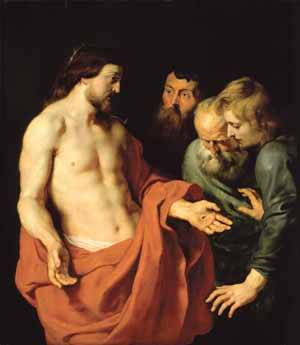Even so, doubters like Thomas can be great teachers if they prompt us to examine our own faith. Doubting Thomas imparts three important lessons about faith.
First, Thomas reminds us that faith does not exclude doubt and questions, nor does it exclude moments when we wonder whether God is truly with us, faithful to Gods promises. Sometimes God may seem distant and unresponsive as we face darkness, illness or helplessness before the dying of a loved one. Faith is not always clear and unchallenged. Yet we are asked to believe in the midst of the questions and uncertainties that surround us. Faith may lead to certitude, though not the comfortable certitude of logic and scientific proof, but rather the certitude of one who trusts in Gods word. We identify with the father in the Gospel who prays with great honesty, I believe. Help my unbelief (Mk 9:24).
Second, Thomas reminds us that we receive faith in and through the community of parents, friends and church. Thomas found faith because he returned to the community and trusted enough to show up the following Sunday. Ultimately, however, Thomas testifies to the fact that our faith must be rooted in our own experience of God, in a personal acceptance of God and commitment to God. We cannot simply believe because someone else believes. Our faith must be founded in our own deepest convictions. At times, we may rely on the faith of others to support us and sustain us, but others cannot believe for us. We have to say our own personal yes to the invitation to faith given by God.
Third, Thomas reminds us that faith is not simply an assent to doctrines and propositions of faith. Thomas had no creed to accept. In fact, the apostle Thomas did not know the Apostles Creed. He had no idea that Jesus had two natures united hypostatically in one person. He had not figured out that there were three persons in one God. He was totally unaware that 10 days earlier, at Jesus last supper, the bread and wine had been changed into the body and blood of Christ. Thomas would have flunked the most basic quiz on the catechism.
Yet he dramatizes for us that, while it is vitally important that we believe that certain doctrines are true, we must first believe in God, the God revealed in Jesus. Thomass faith was a personal response, a graced surrender to the risen Jesus as his lord and savior and an acknowledgment that Jesus spoke the truth when he said, I have the power to lay my life down and I have the power to take it up again (Jn 10:18). As portrayed in Johns Gospel, faith for Thomas was an expression of loyalty, faithfulness and allegiance to Jesus. It was a radical act of trust and a personal commitment to Jesus and Jesus invitation to new life. Thomas reminds us that, in the end, we believe because we know we are loved. We believe in the one who loves us.
In those times when we identify with Thomass doubts, we may boldly ask Jesus to show himself to us. If, like Thomas, we find ourselves isolated from the community of faith and envious of others faith, which seems strong and unwavering, we may hesitate to rely on the word of others who try to encourage us to believe. Then Thomas may assure us in our doubts. But he also challenges us to deepen our faith, trust and commitment to Christ, even if we have not seen him.
What the doubting and believing Thomas teaches us may purify and enrich our own faith. It may also raise questions about how we can best pass on the faith, how we catechize and how we invite people to come to faith. How do we engage their hearts as well as their heads? How do we lead others to encounter Jesus in an intimate way that evokes our trust and surrender and not simply our adherence or intellectual assent?
The Gospel story does not tell us whether Thomas put his fingers in Jesus wounds or touched his side, but he did meet Jesus face to face. That is how he heard the call to faith and where he found the strength to believe and live out that faith as an apostle and martyr. We too are invited to encounter the Lord face to face in word, sacrament and community and in the poor and the needy. Christ is always in our midst inviting us to touch him and believe.








